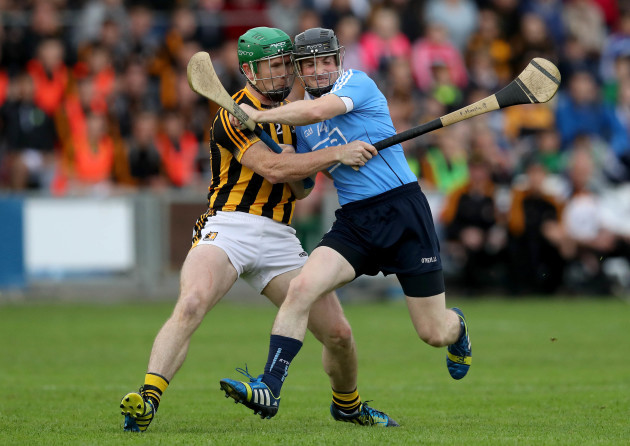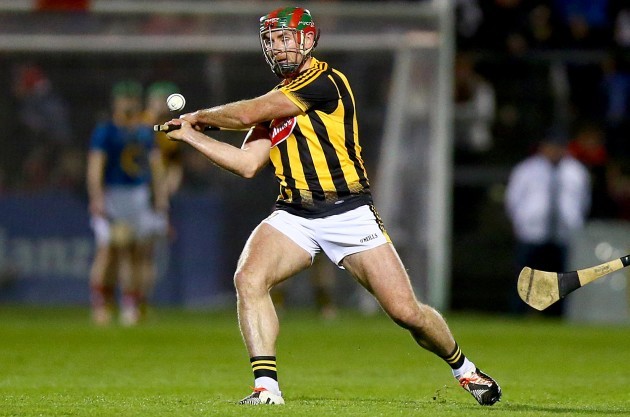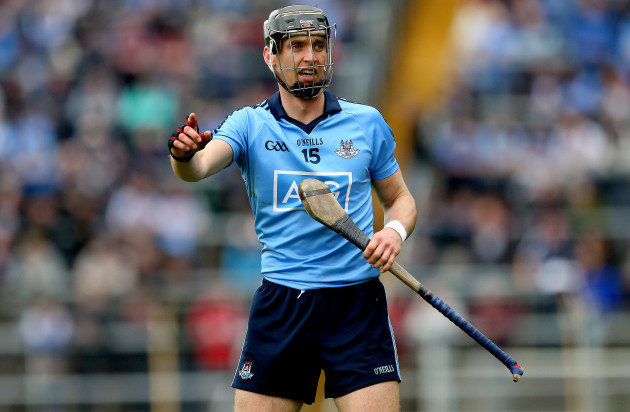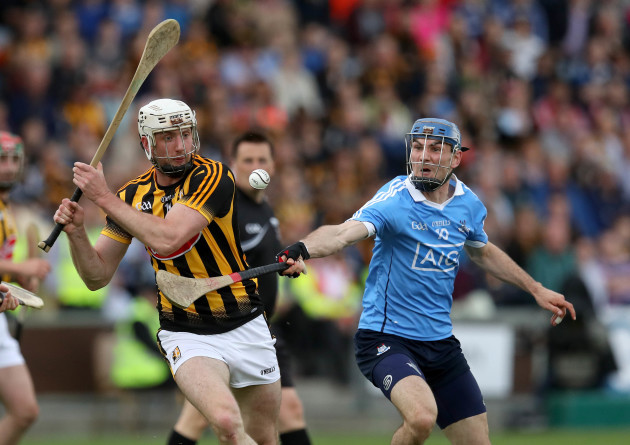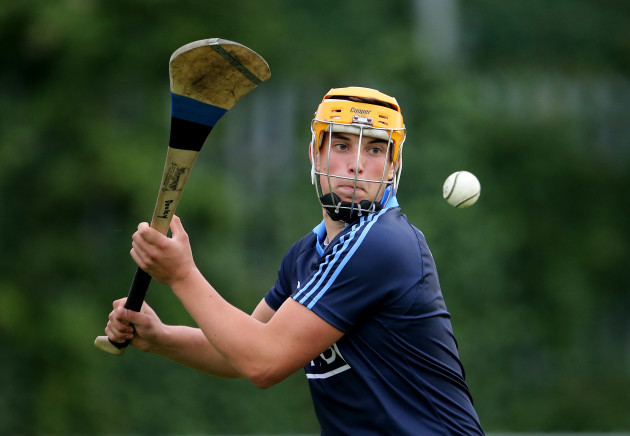AS PART OF our 2016 Hurling championship coverage, we’ve enlisted the expertise of Tipperary’s 2001 All-Ireland winning captain and former team coach Tommy Dunne.
Tommy has joined The42 for the summer and in his latest column, he takes a closer look at Kilkenny’s impressive victory over Dublin at O’Moore Park on Saturday evening.
**************************
KILKENNY NEVER LOOKED like they were going to lose this game.
What stood out a mile for me was their ability to dominate the 50-50 contests, all over the field.
What I mean by that is that when a ball came between two players, one from Kilkenny and one Dublin, if Kilkenny didn’t win the ball clean, they were still in control of the contest. So even if the Kilkenny player didn’t gain primary possession at the first attempt, he was on hand to pick off the break off the initial contest. They were just completely in charge.
The Kilkenny back-line completely overwhelmed the Dublin forwards. Paul Murphy, in particular, completely dominated from corner back. Not only was Murphy stopping Dublin attacks at source, he was also an attacking influence with a number of his long-range deliveries leading to scores, including Jonjo Farrell’s goal.
This is where Dublin missed Mark Schutte desperately. Mark is a player I’ve worked with when I was involved during Anthony Daly’s time and in Danny Sutcliffe’s continued absence, he’s their best forward, in terms of physicality, his ability to win possession, score and bring other players into play.
He’s a player who, in my opinion, would make any forward line in the country. But not having Schutte, obviously, wasn’t the only factor in Dublin’s defeat.
Off-day for Niall McMorrow
Niall McMorrow is a player Dublin needed heavily involved in the game to have any chance of causing an upset.
He’s a very good ball player and striker, a guy I had earmarked to be one of the potential key influencers.
I kept a close eye on him but he didn’t have the ball in hand until the 26th minute, his very first play by my reckoning, and was turned over.
Niall’s second play was a simple off-load and with his next one, he shot a wide.
Niall’s fourth play saw him drive a nice cross-field pass to Eamonn Dillon but that was the sum total of his first-half efforts.
Niall was a peripheral figure and had no influence on the game whatsoever, in truth, but Dublin’s forward line struggled throughout.
Dotsy O’Callaghan was having some joy and in fairness to Daire Plunkett and ‘Trollier’ Dillon, they had good moments but no real questions were asked of the Kilkenny back-line.
Watch Kilkenny’s six backs when the ball comes into their areas. The way they attack it is phenomenal.
Paul Murphy, Cillian Buckley and Kieran Joyce were tight on their men, with Joyce picking up McMorrow.
Going for the ball, they match their men stride for stride if starting from behind but more often than not, they’re in front of their direct opponents.
They wiped out Dublin, who were staying in touch in the first half through David Treacy’s frees. Kilkenny’s half-back line, in particular, set the terms of engagement right from the start.
It begs the question – how did Clare score 4-22 against them in the Allianz League semi-final? My impression is that Clare did in that game what Tipperary did to Kilkenny in the 2010 All-Ireland final, pulling their defenders all over the place, often outside the half-forward line, leaving one-on-one situations inside.
This is where Schutte’s absence was most keenly felt. He can play that edge of the square role brilliantly and he’s mobile. He’ll cover into the corners on diagonal balls and he’s good in the air.
The other technical point on this is that if you watch Mark Schutte when he gets the ball in hand in a one-on-one scenario, he’ll try to go past his man at least eight out of ten times.
He has the athleticism and power to actually break a tackle but some of the Dublin forwards don’t have that expertise. Dotsy, McMorrow and David Treacy are a different style of player, they’ll hurt you more from the outside. And even if they get in one-on-one situations, they’re not the type of player than can break tackles and get inside.
Also, you’ll generally expect to see players playing the number 11 role on the ball an awful lot.
Look at McMorrow’s counterparts like Tony Kelly in Clare, Waterford’s Pauric Mahony, even Noel McGrath and John ‘Bubbles’ O’Dwyer from Tipp when they roam – these are players that are capable of scoring from outside, carrying the ball forward or delivering a ball inside that will ask a question of a corner or full-back.
Dublin didn’t have any of that on Saturday evening. I also decided to monitor Kilkenny’s TJ Reid and he was in cruise control. He missed a few but hit five frees in the first half and was involved in six other plays, one of them a clever cross-field free that found Pádraig Walsh in acres of space, and he pointed.
Even if it was a quiet evening generally for TJ, he still produced some magical moments, winning a couple of long deliveries clean in the air. Later in the championship, TJ will become more influential and his goal threat will increase.
Kilkenny ‘bolter’ Jonjo Farrell
On his championship debut last summer, Ger Aylward lit up Nowlan Park when he scored 3-5 from play against Wexford.
A year on, and with Aylward unfortunately ruled out for the season through injury, Jonjo Farrell pulled on the number 13 shirt and scored 1-5 from play.
It was a brilliant contribution and Farrell is almost a carbon-copy of Aylward in terms of how he plays, his work-rate and accuracy.
Here, in the first half, Farrell hangs on the edge of a ruck and slots the ball calmly over the bar:
The clip above shows good awareness from Farrell, and game intelligence. His second half goal was something else entirely, and leads into a fundamental point that I wish to make about Kilkenny’s forward intent.
All over the field, Kilkenny were very aggressive on the ball (Walter Walsh another to excel) and not only do their forwards attack opposition defenders, they put them on the back foot and go past them.
That’s something Dublin were not able to do, as noted above, but Farrell did it brilliantly.
Farrell does terrifically well for the goal. It wasn’t a goal chance when the ball came his way but he turned it into one.
Look at the clip below closely and you can see that Farrell is ‘outside’ defender Oisin Gough, who is tight on him, but maybe half a yard off.
Jonjo makes him pay for that and shrugs him off before applying a deadly finish. Gough wasn’t able to break Farrell’s stride and couldn’t do enough to effect any sort of tackle.
Kilkenny run hard and straight at their opponents and that’s very difficult to defend against. There weren’t too many examples of Dublin forwards doing likewise at the other end of the pitch, where a Kilkenny defender was asked a question in a one-on-one situation. Kilkenny forwards, when they get even a sniff of goal, ask serious questions.
I heard suggestions after the game that Kilkenny’s full-back line remains vulnerable and while there might be some merit in it as the season progresses, you couldn’t reach that conclusion based on what Dublin offered.
Dotsy O’Callaghan forced a good save from Eoin Murphy in the first half and was also fouled by Joey Holden when he got inside him on an all too rare occasion, an incident that saw the Kilkenny man booked, but how you measure a back-line is to look at how much damage the opposition players did.
You couldn’t say that any of the Kilkenny backs were overly distressed by what the Dublin forwards brought to the table.
The Fennelly factor
Michael Fennelly remains a colossal figure for Kilkenny, due to the positions he plays in, primarily midfield and in the half-forward line.
Fennelly is a real lynchpin, one of their most influential and important players. If you look at him closely, he has huge presence about him and is a player that Kilkenny can rely on when the games get really physical, really intense and there are 50-50 or 60-40 balls that need to be won.
He consistently comes up with big plays, tackles, carrying the ball past opponents and cutting out danger when required. One of Fennelly’s great hallmarks is that he’s generally able to do the right thing at the right time, his decision-making is very good.
It’s a remarkable feat that he can play so few League games and still come through and turn out great championship performances. In my experience, that’s pretty unusual.
An early point from Fennelly, from a poor Dublin puck-out (a strategy that I will discuss in more detail shortly), illustrated his value. After cutting out a Conor Dooley puck-out, the ball fell to Lester Ryan.
Fennelly was already moving into a position for a return pass and when the ball was returned to him, he slotted it over the bar with minimum fuss.
Fennelly also supplied an assist for Cillian Buckley’s first half point and in the second half, he denied Daire Plunkett a goal with this excellent intervention:
Dublin picked up the pieces to score a point through Dotsy O’Callaghan but Fennelly’s tracking back ensured that Kilkenny didn’t concede a goal.
Dublin’s puck-out woes
Dublin were already in trouble from puck-outs in the first half, with half-time stats showing that Kilkenny won 17 from a combined total of 27, but they were all over the place in the second half.
I was sitting in the stand at O’Moore Park and kept a close eye on Dublin’s first 13 puck-outs after half-time. The results don’t make for good reading.
- 1 – lost and results in a point from play for Kilkenny’s Jonjo Farrell
- 2 – won but Darragh O’Connell is forced out over the line
- 3 – Conor Dooley’s puck-out is picked off by Walter Walsh, who sends over a Kilkenny point
- 4 – won but David Treacy fouls the ball and Kilkenny are awarded a free
- 5 – won but Johnny McCaffrey is swallowed up and Kilkenny win a free
- 6 – won but Eamonn Dillon is forced out over the line
At this point, it should be noted that Dooley then coughs up another cheap effort, from play this time, and Walter Walsh feeds Pádraig Walsh for a shot that goes wide.
- 7 – won short and leads a point chance for Dotsy O’Callaghan but he’s brilliantly blocked by the outstanding Paul Murphy and Kilkenny clear their lines
- 8 – won short and Dublin get into a promising position but the move breaks down. Kilkenny switch play to the other end and Chris Crummey is booked for a foul on Farrell
- 9 – lost and Paul Murphy feeds Cillian Buckley for a Kilkenny point
- 10 – lost and Paul Murphy, again, pops the ball to TJ Reid, who forces a save from Dooley and misses the 65
- 11 – Paul Murphy wins his third puck-out in a row and his delivery leads to Jonjo Farrell’s goal
- 12 – won but Dotsy’s shot at goal drops short
- 13 – clean win in the air by Kilkenny’s Cillian Buckley
In that 12-minute period of time, Kilkenny scored 1-8 without reply and put the game out of Dublin’s reach.
Even when Dublin won their own puck-outs, they either lost possession, were forced out over the line or frees were given against them. They effectively got no return from those first 13 puck-outs of the second half and that’s ‘wipe-out’ time.
Dooley’s distribution was suspect overall and a lot of Dublin’s problems stemmed from that. The pitch dimensions of O’Moore Park are pretty similar to Semple Stadium and Croke Park but there’s still a ‘tighter’ feeling about the place and you don’t have the extra half-second or second to play with.
That’s a factor too, in that it’s harder to execute puck-outs and when you find yourself in trouble from them, far more difficult to dig yourself out of a tight spot.
The42 is on Snapchat! Tap the button below on your phone to add!
